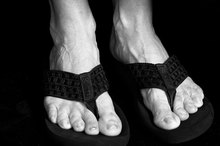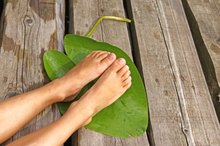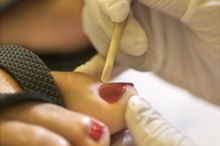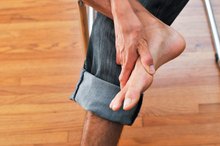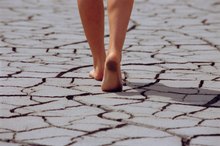How to Remove Corns and Bring Skin Color Back
While your favorite pair of heels or boots may look glamorous, they can take an unappealing toll on your feet. Excess foot pressure, particularly between the toes, can lead to corns -- thick layers of skin with a solid core 3. Corns can be painful and often require long-term treatment, particularly if they affect bones and nerves. Corns pull the skin taut, resulting in inflammation that creates an uneven skin tone. While you should seek treatment from a medical professional, you can reduce the size of corns and treat the discoloration at home.
Fill a tub with enough warm water to cover the tops of your feet. Pour 1 tablespoon of Epsom salts into the water. Epsom salts will soften the corns, making them easier to remove
How to Remove Corns & Bring Skin Color Back
Learn More
Set your feet into the tub and allow them to soak for 30 minutes. If you find the water too hot, add some cool water to the tub to avoid burning your feet.
Remove your feet from the tub, and gently pat them dry with a clean towel. Sit comfortably and prop one foot up so you have a clear view of the corn.
How to Fix Cracked Heels
Learn More
Position a pumice stone over the corn and gently massage it, moving toward your toes and back toward your heel again. Continue until the outer layer of dead skin has been removed.
Soak a clean washcloth in cool water and wipe away any remaining flaky skin from your feet. Cool water will soothe the skin to diminish redness.
Pour a quarter-sized amount of lactic acid-based moisturizer into the palm of your hand, and gently massage it into the area. Lactic acid gently renews the skin to bring back its natural tone.
Pull on a pair of socks to lock in the moisture, and wear them overnight.
Tips
Your feet will be sensitive after the treatment, so it's best to treat corns at night when you will be off of them for several hours afterward.
Visit a doctor to treat painful corns or open calluses. It is only healthy to gently remove dead skin at home, and you should not attempt to treat an infected area.
Related Articles
References
- Dr. Oz: All About Feet: Cold Feet and Callus Cures
- Podantics Podiatry: Calluses
- DeLauro T and DeLauro M (2012) Chapter 98: Corns and Calluses. Fitzpatrick's Dermatology in General Medicine (8th Edition). New York, New York: McGraw-Hill Education. ISBN-13: 978-0071669047.
- American Academy of Dermatology Association. How to treat corns and calluses. 2019.
- Reddy P, Anusha T, Haritha N, Nagendra A, Bhavani D, Gandhimathi R. Case report on non-surgical treatment for foot corn. International Journal of Dermatopathology and Surgery. 2018;4(1).
- American Academy of Dermatology Association. How to Treat Corns and Calluses. 2019.
- DeLauro T and DeLauro M (2012) Chapter 98: Corns and Calluses. Fitzpatrick's Dermatology in General Medicine (8th Edition). New York, New York: McGraw-Hill Education. ISBN-13: 978-0071669047.
Writer Bio
Celeigh O'Neil has been writing professionally since 2008. She has a Bachelor of fine arts from the University of Ottawa, as well as degrees in fashion illustration/design, digital arts and certification in hair and makeup artistry. O'Neil was a frequent contributor to Toronto's "Dialog" newspaper and has worked as an instructional writer, creating lessons in fashion, art and English for students of all ages.
